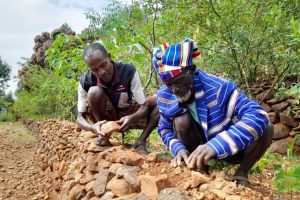
Addis Ababa, the capital city of Ethiopia, is considered as a model Ethiopia seeing that the various Nations, Nationalities and Peoples of the country live under its umbrella with harmony, togetherness, love, respect, among others. Moreover, as everyone is aware, the city comprises a wide spectrum of big villages in the length and breadth of the country.
To name a few, there are Arat Kilo, Piassa, Mercato, Bole, Kassanchise, Kotebe and Sholla. Most recently, the various vicinities of the capital possess their own history. Furthermore, at this point in time, every nook and cranny of Addis Ababa has been experiencing tremendous transformations time and again.
The focus of this writer is not attaching weight to Ethiopians residing in the capital city but to acquaint the regular readers of The Ethiopia Herald newspaper with the basics of the people of Shiro Meda for the most part Gamo weavers living in the aforementioned vicinity. The Gamo people have their own mourning ceremony, wedding ceremony, dining culture, among others.
Above and beyond, their cultures, traditions, and norms attract the attention of everyone within the shortest time possible. In actual fact, much has been said about the people of Gamo for the most part those who make a living engaging themselves fully in weaving. No one can deny the fact that Gamo weavers have been known for producing attentiongrabbing traditional Ethiopian clothes since time long past.
The people of Ethiopia and costumes are turning out to be two sides of the same coin at this point in time. In the same way, the vicinity of Shiro Meda is famed for putting up for sale traditional clothes in various shapes and forms. More often than not, most people put traditional clothes on when they attend funeral processions, a wedding ceremony, mass, memorial party and what have you.
Someday, I headed straight to Shiro Meda, which is known for manufacturing traditional clothes. The area was surrounded by a wide spectrum of attention grabbing traditional clothes. While I was taking a walk around there, I bumped upon foreigners buying Ethiopian traditional clothes while some of them were window shopping.
After I took a walk, I stumbled upon weavers standing around the shop holding bunch of clothes for sale. Almost immediately, I approached one of the wavers named Bogale Zahe to have his reflection on the existing situation of the traditional clothes. He said, “I have been getting myself involved in weaving business in all my born days.
I work against and around the clock. I know weaving like the back of my hand. But I feel I am leading a meaningless life at this point in time. The whole lot costs an arm and a leg. It is skyrocketing time and again. No matter how hard I try, I managed to change my life to the end of time.
Most people would like to buy our manufactured goods cheap. They do not understand the reality on the ground. I am giving up hope in this regard.” He continued, “These days, the number of people adorning themselves with traditional clothes and other key aspects regarding our manufactured goods is on the rise.
As bad luck would have it, the presence of machine made traditional clothes in some areas of the capital is throwing cold water on the original ones. Even worse, most people are shifting to traditional clothes compared to the original ones at this moment in time. To the best of my knowledge, above all, as price does not matter, customers should attach significance to quality and originality.”
Shiro Meda is one of the areas of Addis Ababa found in Gullele sub city where quite a lot of weavers make a living producing a wide spectrum of clothes and putting on the market their products to customers on a daily basis. Their social bond is very strong. Every so often, they build stronger social bonds.
As far as I have observed, the Shiro Meda Gamo community weavers in most areas make use of a wide variety of raw materials for weaving purposes such as threads, cotton, spun, warp, weft and what have you. Moreover, they spare no effort to add eye-catching color to traditional clothes in addition to making various designs which can win the hearts and minds of all and sundry in the twinkling of an eye.
The Gamo community living in the length and breadth of the vicinity of Shiro Meda make a living getting them engaged in various activities. In the same way, the weavers are known for fashioning attention-grabbing color combination for various traditional clothes making use of different raw materials like cotton and threads.
It is no secret that the art of weaving is not as simple as falling off a log. It requires a range of technical aspects. It is not that easy. The Gamo community living in the left, right and center of Shiro Meda get themselves involved in a wide spectrum of self-help association.
To begin with, as I learnt from a research paper conducted by Biniam Kedir, Jerry Daba, Mekete and the like, Idir plays a major role in smoothing the progress of personal development amongst the Gamo community. In the sub city, more than eighty Idirs are available which encompasses hundred to four hundred members.
Though the major activities of Idirs are lead by chairmen, they consist of vice chairman, secretary, monitoring committee, cashier and facilitators. As everyone is aware, the chairman is responsible for leading the organization, opening and closing meetings and presenting issues for amendments. By the same token, the deputy chairman is responsible for chairing in the absentia of the chairman.
In the same way, the secretary is accountable for a variety of issues such as recording list of members, various documents and other related aspects, while the monitoring committee is liable to supervising the entire process in addition to smoothing the progress of auditing and reporting.
Idir plays a major role in making possible the socio economic activities of the community in addition to lending a hand to the community for the most part when members of the Idir kick the bucket and do not feel themselves.
More to the point, most members get themselves involved in constructing roads in the sub city by raising awareness to the community apart from working with pertinent bodies of the districts. Above and beyond, they involve themselves in conflict resolution whenever the need arises.
It is obvious that weaving is the leading profession amongst the Shiromeda Gamo community for the reason that they inherit the line of work from their parents. It has been passing down from generation to generation. As far as I am concerned, the general public should attach significance to the homemade Ethiopian traditional clothes than paying money for machine made traditional clothes.
The Ethiopian Herald Sunday Edition 7 July 2019
BY ADDISALEM MULAT.





